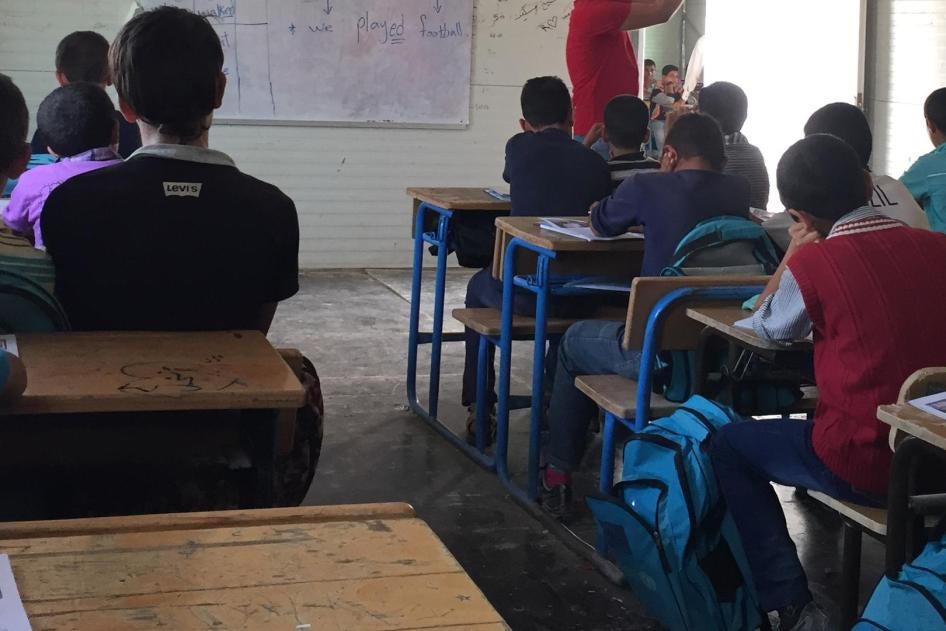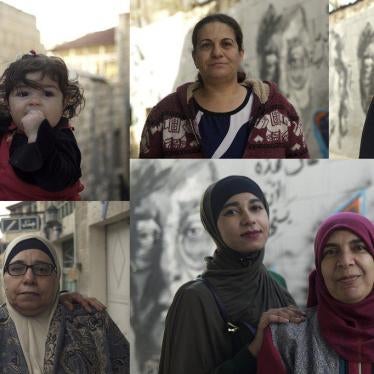Update (March 29, 2018): An earlier version of this news release stated that as of March 20, 2018, about 3,300 Syrians had signed up for Jordan’s “amnesty” to formalize their residency in urban areas. The news release has been updated to reflect that by March 25, Syrian families comprising nearly 22,000 individuals had approached UNHCR, the United Nations refugee agency, which had issued 4,947 asylum seeker certificates to individual Syrians and scheduled interviews with the rest.
(Amman) – Jordan began on March 4, 2018 to regularize the status of many refugees who have been living in towns and cities without permits, offering them greater protection, Human Rights Watch said today. However, on January 24, the government revoked the eligibility for subsidized health care for people living outside refugee camps.
The March 4 decision will protect thousands of vulnerable Syrian refugees from arrest for being outside refugee camps illegally and will increase their access to jobs, aid, and education. But the healthcare decision will leave many people unable to afford care.
“The move to regularize the status of Syrian refugees in Jordan’s urban areas means that they no longer have to live underground, promising a better future for their children,” said Bill Van Esveld, senior children’s rights researcher at Human Rights Watch. “Jordan and its international donors should not undermine these improvements by pulling the rug out from under refugees on health care that families are already struggling to afford.”
In a survey of Syrian refugees living outside camps, the United Nations children’s agency, UNICEF, reported in February that 45 percent of Syrian children under age 6 are not getting necessary health care such as vaccinations. And 85 percent of Syrian children in Jordan live below the poverty line, the survey found.
The “regularization,” or “amnesty,” announced by the UN refugee agency, UNHCR, applies to Syrians who left Jordan’s refugee camps without government permission to seek better living conditions in towns and cities, but who were unable to meet Jordan’s stringent conditions to register as asylum seekers outside camps. It also includes Syrians who have not registered with UNHCR. The change should affect 30,000 to 50,000 Syrians. By March 25, more than 22,000 Syrians had signed up.
Previously, Syrians stopped by the police who could not prove that they left the camps lawfully were liable to arrest, involuntary transfer to refugee camps, or to be summarily deported to Syria. Police also often arrest people working without authorization. The vast majority of Syrian refugees in Jordan live below the poverty line.
The healthcare decision will require Syrian refugees in urban areas to pay the same rates as other foreigners at public hospitals, with 80 percent up-front. The Syrian refugees had free health care from 2012 to 2014, and since then had received the same subsidies as uninsured Jordanians.
More than three-quarters of Syrian households surveyed in 2017 whose members had been unable to get medicine or care for chronic conditions said they could not afford it. Jordan’s latest response plan for the Syrian refugee crisis notes that 36 percent of urban refugees cannot afford needed medicines or health services, possibly causing some to move to refugee camps, where aid agencies and nongovernmental groups provide health care.
Virtually all Syrian refugees who have fled to Jordan since mid-2012 were initially taken to the Zaatari or Azraq refugee camps, where most registered with UNHCR. Until July 2014, Jordan allowed refugees to leave the camps and move to urban areas, but later only allowed them to move if sponsored by a close relative who met other stringent conditions. That process was suspended in early 2015, leaving people in camps able to leave only briefly with “vacation passes.”
The amnesty, in effect until September 27, applies to Syrians who left the camps without permission before July 1, 2017, as well as those who never registered with UNHCR. The new policy will allow them to register as refugees with UNHCR and then regularize their status with the Jordanian police.
The arrests of Syrian refugees who could not prove they were outside of camps legally contributed to child labor, as families have been split up and children have had to drop out of school to work if their fathers were arrested and sent to refugee camps. Poverty among Syrian refugees has also driven an increase in rates of child marriage. Previously, Syrians living outside camps without permission were also unable to get the special identification cards needed to apply for work permits and enroll in school, though Jordan has since waived the requirement for school enrollment. Those living outside the camps without permission were also ineligible for monthly cash grants from UN agencies for the most vulnerable refugee families, including to buy food and offset the costs of attending school.
The regularization policy could increase access to education for Syrian refugees, and the ability to live more securely may enable them to improve their ability to succeed academically. Only 126,000 of 220,000 school-age Syrian refugee children were enrolled in the 2016-2017 school year, the most recent figures available. Access to the government identification card and UNHCR asylum seeker certificate could also make more Syrian adolescents and youth eligible for vocational training programs and university scholarships.
But the change in health care could have the opposite effect, Human Rights Watch said. The most recent available UN survey indicates that Syrian refugees were already spending 41 percent of their monthly income – averaging 243 JOD or US$343 – on health care. Under a 2016 Health Ministry decree, Syrians are eligible for free pre- and post-natal care, family planning, and vaccinations. But an association of international humanitarian groups in Jordan reported on March 18 that, after the January 24 change in health care, public health facilities are not consistently providing those services to Syrian refugees.
Jordanian officials have not explained the change in healthcare policy, but have in the past cited high health care costs for Syrian refugees. From the beginning of the Syria conflict to the end of 2016, Jordan said it had spent 1.5 billion Jordanian dinars (US$2.1 billion) on health care for Syrian refugees, and estimated direct healthcare costs at over US$115 million annually from 2018-20.
International humanitarian funding for refugees in Jordan, which hosts more than 650,000 registered Syrian refugees in addition to Iraqi and other refugees, provided only about 66 percent of healthcare needs in 2017, and half of the overall humanitarian budget. International donors should live up to their pledges to support Jordan as a host country for Syrian refugees, Human Rights Watch said. As of February 2018, UNHCR had received only US$17.8 million out of the $274.9 million budget it needs for Jordan in 2018.
Refugee law requires countries to “accord to refugees lawfully staying in their territory the same treatment with respect to public relief and assistance as is accorded to their nationals,” including health care. The Convention on the Rights of the Child, to which Jordan is a party, recognizes the right to health for all children, without distinction based on nationality or immigration status.
“Jordan’s new amnesty should mean less fear, anxiety, and suffering for Syrian refugee children and their families, and yet its altered healthcare policy will mean the opposite,” Van Esveld said. “With support from international donors, Jordan should move toward a coherent approach that ensures all Syrian refugees’ rights and gives Syrian children a meaningful chance at a better future.”







